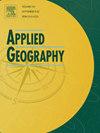Unveiling interprovincial geographic patterns of 5A-level tourism cultural ecosystem service flows and tourist preferences in China's metacoupled systems
IF 4
2区 地球科学
Q1 GEOGRAPHY
引用次数: 0
Abstract
In the metacoupling Anthropocene, tourism-based culture ecosystem services flows (CESF) can establish non-material bridges from the natural to the human system, even across vast geographic distances. However, there remains a knowledge gap regarding investigation of nature-related tourist travel patterns at geographic flow scales. To address this gap, we analyzed the intracoupling (within-province), pericoupling (adjacent-province), and telecoupling (distant-provincial) flow patterns using a sample of 143,681 5A attractions travel comments with Internet Protocol (IP) location data. Emotional preferences derived from travel reviews were then quantified using machine learning models in China's post-COVID-19 pandemic era. The results showed significant spatial differences in nature-based 5A-level CESF, China's telecoupling performance of CESF (0.34) is higher than pericoupling (0.20), but intracoupling (0.46) remains dominant. Tourists from northeastern provinces exhibited a preferences for telecoupling, while those from southwestern provinces showed intracoupling patterns. Forest ecosystems contribute nearly one-third (30.70%) of cultural services and are primarily characterized by intracoupling patterns. Sentiment analysis indicated that tourists' emotional preferences vary with travel distance, with long-distance tourists tending to appreciate indigenous cultures. Overall, this study provides new insights into investigating the dynamics of CESF, which could inform policy actions aimed at revitalizing the tourism sector.

揭示中国元耦合系统中 5A 级旅游文化生态系统服务流的省际地理格局和游客偏好
在元耦合的人类世,以旅游业为基础的文化生态系统服务流(CESF)可以建立从自然到人类系统的非物质桥梁,甚至可以跨越遥远的地理距离。然而,在地理流量尺度上对与自然相关的游客旅行模式的调查仍是一个知识空白。为了填补这一空白,我们使用 143,681 条带有互联网协议(IP)位置数据的 5A 景点旅游评论样本,分析了省内(省内)、周边(邻省)和远程(远省)的流动模式。然后,在中国后 COVID-19 大流行时代,使用机器学习模型对旅游评论中的情感偏好进行量化。结果显示,基于自然的 5A 级 CESF 存在明显的空间差异,中国的远程耦合 CESF(0.34)高于周边耦合(0.20),但内部耦合(0.46)仍占主导地位。来自东北三省的游客表现出远程耦合偏好,而来自西南省份的游客则表现出内部耦合模式。森林生态系统贡献了近三分之一(30.70%)的文化服务,并主要表现为内耦合模式。情感分析表明,游客的情感偏好随旅行距离而变化,长途游客倾向于欣赏本土文化。总之,本研究为调查 CESF 的动态提供了新的见解,可为旨在振兴旅游业的政策行动提供参考。
本文章由计算机程序翻译,如有差异,请以英文原文为准。
求助全文
约1分钟内获得全文
求助全文
来源期刊

Applied Geography
GEOGRAPHY-
CiteScore
8.00
自引率
2.00%
发文量
134
期刊介绍:
Applied Geography is a journal devoted to the publication of research which utilizes geographic approaches (human, physical, nature-society and GIScience) to resolve human problems that have a spatial dimension. These problems may be related to the assessment, management and allocation of the world physical and/or human resources. The underlying rationale of the journal is that only through a clear understanding of the relevant societal, physical, and coupled natural-humans systems can we resolve such problems. Papers are invited on any theme involving the application of geographical theory and methodology in the resolution of human problems.
 求助内容:
求助内容: 应助结果提醒方式:
应助结果提醒方式:


